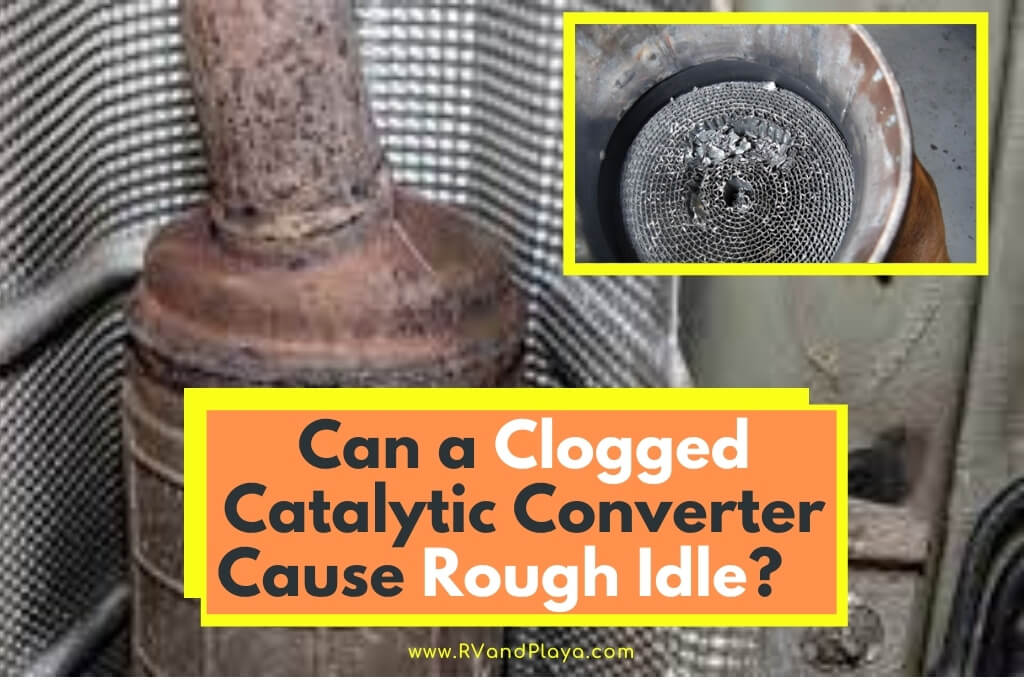Have you ever wondered if a clogged catalytic converter causes rough idle? Look no more. We´ve got you covered.
A core component of your vehicle’s ignition and exhaust system, catalytic converters are designed to run free and clear while protecting the environment from harmful toxins and gases caused by our vehicle’s engine.
Over a long enough block of time, though, our catalytic converters can become gummed up and clogged.
This produces a whole bunch of problems for drivers, especially those that aren’t particularly mechanically inclined and may not know exactly what’s wrong “under the hood”.
So, can a clogged catalytic converter cause rough idle? Yes, a clogged catalytic converter can cause rough idle. There are a lot of different symptoms of a catalytic converter clog, but one of the “classic” issues lots of people end up experiencing is a rough idle. Over time, however, that catalytic converter is only going to get more and more gummed up.
Table of Contents
Can a Clogged Catalytic Converter Cause Rough Idle?
Most of the time, this rough idle starts off very slight. Sometimes so slight it’s nearly imperceptible.
Maybe you notice your vehicle chugging along when you first fire it up before everything smooths out while cruising down the highway.
Maybe you notice your vehicle “chattering” when you are idling at a red light, but the problem goes away as soon as you goose it with a little gas.
That’s going to cause the rough idle problem to increase – and before you know it you are going to be dealing with a whole host of problems on top of that rough idle!
Read also: Can a Catalytic Converter Unclog Itself? (Clear a Clogged)
What Are Other Signs of a Clogged Catalytic Converter?
Before we immediately start pointing fingers at your catalytic converter when you are dealing with a rough idle, though, that’s important to recognize that this isn’t always the culprit.
There are lots of other reasons that your vehicle may have a rougher time idling than you are used to, many of them having absolutely nothing whatsoever to do with your catalytic converter.
To confirm that it is your cat system causing all these problems, you need to be on the lookout for other issues that paint a bulls-eye on your catalytic converter.
Here are just a few of them!
Sluggish Performance
Sluggish performance – a vehicle that just sort of feels like it is running in mud all the time – is often a surefire sign that your catalytic converter isn’t working the way it should be.
When everything is running as intended, your entire vehicle is going to feel silky smooth.
The catalytic converter is going to allow for just the right amount of exhaust pressure to optimize fuel efficiency, improve acceleration, and keep things running like a Swiss watch.
As soon that cat system starts to get gummed up, though, performance takes a nosedive.
You’ll have a rough idle, you might have misfires, and you’re going to just sort of feel something “off” as you are cruising down the road.
Read also: How To Check If Your Catalytic Converter Is Bad (6 Common Problems)
Diminished Acceleration
Another problem you’ll spot when your cat system is starting to fail is diminished acceleration.
A combination of rough idle and diminished acceleration is almost always going to point directly at a catalytic converter that has seen better days.
If you are noticing rough idle at a standstill and then really slow, creeping acceleration as you push the pedal to the metal it’s not a bad idea to consider cleaning out the cat or bringing it to a mechanic.
Black Exhaust Smoke
Black exhaust smoke (even just dark gray exhaust smoke) on a consistent basis is another telltale sign that your catalytic converter has been in better shape.
This black exhaust smoke signals that the exhaust isn’t being cleaned by the converter the way it should be, but is instead releasing all of those harmful gases and chemical toxins into the environment.
If this is happening something in the catalytic converter has failed. Either you have a clog that is forcing these gases to escape in another way or the system internally is broken down and busted.
No matter what, black exhaust smoke and a rough idle means your cat needs to be inspected straight away.
Rotten Egg Smell
Rotten egg smells (sulfur smells) let you know that your catalytic converter isn’t working the way it should be. Combine that with a rough idle and you know right away what has to be taken care of.
Extreme Heat Under the Vehicle (Overheating)
Finally, if you have a rough idle and extreme temperature swings when you run your vehicle there’s a high likelihood that your catalytic converter isn’t operating efficiently.
Sometimes you’ll notice the temperature gauge start to climb while you are idling, and sometimes you’ll notice extreme temperature (overheating) when you feel underneath your vehicle.
Obviously, there’s always going to be a bit of heat anytime you put your hand near your exhaust system. But you should still be able to get your hand within a few inches and not feel like you’re reaching out to the sun.
Extreme heat is always a surefire sign of a catalytic converter breaking down, particularly when paired with a rough idle.
Can a Bad Catalytic Converter Cause Hard Shifting
Yes, a clogged catalytic converter makes the engine work harder, which in turn makes it difficult and hard to shift the transmission. So, it will lead to trouble shifting gears in your vehicle.
Can a Clogged Catalytic Converter Be Fixed?
Absolutely!
In fact, cleaning out a clogged catalytic converter is often a whole lot easier than most people expect.
It’s a job anyone can do all on their own with just a little bit of time, a little bit of research, and some smart purchases.
The very first thing you’ll want to do is gently tap on the catalytic converter when it is ice cold. A small hammer works wonders for this project.
The reason you want to tap the catalytic converter is you want to determine whether or not it is just gummed up and choked or actually broken.
If you hear a rattling noise, like something is bouncing around inside of the catalytic converter, that means that there’s actually a problem with the cat converter physically.
It has to be replaced and repaired – cleaning it out isn’t going to get the job done.
If, on the other hand, you don’t hear anything other than the ding when you gently tap the converter itself you’ll be looking at a clogged issue 99.99% of the time.
The next piece of the puzzle is to research what kind of cat cleaner you need for your specific vehicle
Catalytic converter fluids are different for each make and each model. You have to be certain that you’re using the right stuff for your particular vehicle. A quick Google search will turn this information up for you, though.
Read also: How to Remove a Catalytic Converter Without Tripping the Check Engine Light
After that, you’ll want to read the label of that catalytic converter cleaner to see how much cash you need in your tank before mixing the fluids.
Some are going to tell you that you need a half a tank, others are going to require a little more fuel or a little less. At the end of the day, though, it’s important to make sure that this mixture is right on.
You want the fluid to be able to work effectively.
Mix the cleaner into your gas tank and then fire up your vehicle, driving it down the road for maybe 20 minutes or 30 minutes. Really try to get the RPMs up to 2500 or 3000 and maintain them consistently.
This’ll do wonders to push that cleaner through your engine and into your catalytic converter, dissolving and cleaning out the residue that is causing you issues.
You should notice your idle problems disappear within 15 to 20 minutes (and definitely by the time your 30-minute cruise is up).
If, though, your engine is still idling rough – and you’re still noticing catalytic converter symptoms we highlighted above – you might need to run another bottle of cat cleaner through the system.
Rinse and repeat the process we just highlighted above, and maybe drive around for 45 minutes or so this time.
Try to get those RPMs north of 3000 for extended amounts of time if possible (maybe even driving out on the highway).
If after that your rough idle problems still exist it’s time to ring up your favorite mechanic and see if they can help you out.
It may not be a catalytic converter issue you’re dealing with at all at that point – or you may need professional help resolving the catalytic converter problem that simple cat cleaner can’t resolve all on its own.
Here are some of my favorite tools & equipment´s
Thank you for reading this article. I hope it helps you find the most recent and accurate technical and repair information for your car. Here are some tools that I use as an automotive technician and hope you´ll also find helpful.
There are affiliate links, so if you do decide to use any of them, I´ll earn a small commission. But in all honesty, these are the exact tools that I use and recommend to everyone, even my own family. (NO CRAP)
To see all my of most up-to-date recommendations, check out this resource that I made for you!
References
Recent Posts
Is Toyota Remote Connect Free? (Subscription, Services Plans)
Does Toyota Remote Connect have an included trial? It used to be the case that, when you bought a new car, you made one straightforward payment and that was it. Now, it feels like there are...
Toyota Safety Connect: What It Is And Why You Need It? Whether you’re buying a new Toyota or you’ve had one for a while you will have been given the hard sell on their Connected Services but do...


